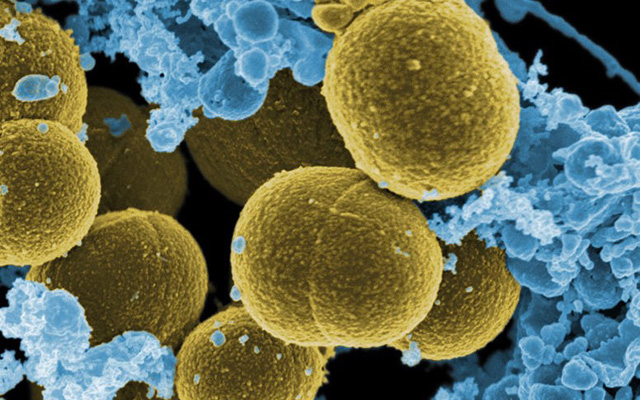UCSD: Healthy human skin is alive with bacteria. In fact, there are more
microorganisms living in and on the human body than there are human
cells. Most can live on the human skin without harming the host, but in
some people bacteria can negatively alter their health, maybe even
become life-threatening. University of California San Diego School of Medicine researchers
screened 10,000 colonies of bacteria found on the epidermis to determine
how many had antimicrobial properties and at what rate these are found
on healthy and non-healthy skin. In a paper published February 22 in Science Translational Medicine,
the team reports isolating and growing good bacteria that produce
antimicrobial peptides and successfully transplanting it to treat
patients with the most common type of eczema, known as atopic
dermatitis.
“We discovered antimicrobial peptides produced by bacteria commonly
found on healthy human skin. These novel antimicrobials have selective
activity against pathogenic bacteria, but do not harm other commensal
bacteria that have a beneficial effect to us,” said Teruaki Nakatsuji,
PhD, project scientist in the Department of Dermatology at UC San Diego
School of Medicine and first author.
The team tested if bacteria normally found on human skin, including Staphylococcus hominis and Staphylococcus epidermis, defend against Staphylococcus aureus — a pathogenic bacteria that aggravates skin conditions like atopic dermatitis. When S. aureus becomes antibiotic resistant it is known as methicillin-resistant Staphylococcus aureus or MRSA. It is a leading cause of death resulting from infection in the United States.
“We discovered that healthy people have many bacteria producing
previously undiscovered antimicrobial peptides, but when you look at the
skin of people with atopic dermatitis, their bacteria are not doing the
same thing. They have the wrong type of bacteria,” said Richard Gallo,
MD, PhD, professor and chair of the Department of Dermatology at UC San
Diego School of Medicine. “After isolating the good bacteria and growing
it, we were able to transplant it back to people who were deficient in
it and it had an immediate impact by reducing the amount of S. aureus on the skin.”
According to the National Eczema Association, nearly 18 million
people in the United States are plagued with atopic dermatitis, the most
common form of eczema, which normally appears as a rash on arms, legs
and cheeks.
The first tests were done in animal models where S. aureus was eliminated by transplanting good bacteria to the area where S. aureus
was found. Success with these models led to a small phase I clinical
trial in which an individual’s good bacteria with antimicrobial activity
was grown, formulated in a skin cream and applied once to the forearm
of the eczema patient infected by S. aureus. The phase I trial
was intended only to test for safety and efficacy, but every patient
treated in this way exhibited a significant decrease in S. aureus on their skin.
“We now have a rational therapeutic approach for atopic dermatitis by
using bacterial transplant technology,” said Gallo. “It appears that
people with this disorder will need to have it reapplied because their
body does not naturally promote the growth of these organisms. The good
thing is this is easy to do because it’s just a cream.”
A phase II clinical trial is just beginning to evaluate whether
prolonged application of one of the most potent good bacteria from human
skin can provide long-term protection against S. aureus and improve atopic dermatitis.
“Using a natural antibiotic produced by the skin microbiome is
superior to current pharmaceutical approaches because the
bacteriotherapy does not kill protective bacteria strains,” said
Nakatsuji. “Antibiotic resistance is not likely to occur because the
bacteria therapy is attacking pathogens by multiple different ways at
once.”
According to researchers, the microbiome is clearly associated with
disease but cause and effect had not been established. This study
reveals one of the chemicals that normal skin bacteria make to help
humans fight off infection or an imbalance in the skin microflora.
Co-authors include: Tiffany H. Chen, Saisindhu Narala, Kimberly A.
Chun, Aimee M. Two, Tong Yun, Faiza Shafiq, Paul F. Kotol, Amina
Bouslimani, Alexey V. Melnik, Haythem Latif, Ji-Nu Kim, Pieter C.
Dorrestein, Karsten Zengler, Tissa R. Hata, UC San Diego; Alexandre
Lockhart, Keli Artis, Gloria David, Rho Federal Systems Division, Inc.;
Patricia Taylor, Joanne Streib, Donald Y. M. Leung, National Jewish
Health; Alex Grier, and Steven R. Gill, University of Rochester.
This research was funded, in part, by the Atopic Dermatitis Research
Network (1 U19 AI117673-02) and National Institutes of Health
(R21AR067547, R01AR06781, R01AI052453, R01AI118816, 1TL1TR001443).
